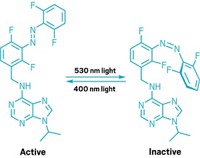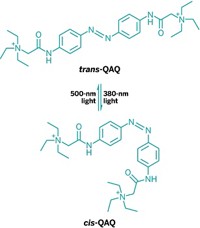Advertisement
Grab your lab coat. Let's get started
Welcome!
Welcome!
Create an account below to get 6 C&EN articles per month, receive newsletters and more - all free.
It seems this is your first time logging in online. Please enter the following information to continue.
As an ACS member you automatically get access to this site. All we need is few more details to create your reading experience.
Not you? Sign in with a different account.
Not you? Sign in with a different account.
ERROR 1
ERROR 1
ERROR 2
ERROR 2
ERROR 2
ERROR 2
ERROR 2
Password and Confirm password must match.
If you have an ACS member number, please enter it here so we can link this account to your membership. (optional)
ERROR 2
ACS values your privacy. By submitting your information, you are gaining access to C&EN and subscribing to our weekly newsletter. We use the information you provide to make your reading experience better, and we will never sell your data to third party members.
Biological Chemistry
Tadpole Tests Confirm Light-Activated Anesthetic Is Reversible
Small molecule enables reversible command of a neurotransmitter’s activity
by Carmen Drahl
September 24, 2012
| A version of this story appeared in
Volume 90, Issue 39
With a switchable version of a popular anesthetic, researchers can now use light to control another important neurotransmitter receptor, the GABAA receptor (Angew. Chem. Int. Ed., DOI: 10.1002/anie.201205475). Scientists have already controlled animals’ heartbeat, pain, and visual response with light-activated blockers of ion channels in the nervous system. To command GABAA, a chloride channel, Dirk Trauner of the University of Munich, Erwin Sigel of Switzerland’s University of Bern, and coworkers made azobenzene derivatives of the anesthetic propofol. GABAA plays a major role in propofol’s activity, though the molecule’s mode of action is not entirely clear. In the dark, the azo-propofols are in the trans form and increase GABAA’s chloride current. Upon exposure to blue-violet light, they convert to the cis form, reversing the effect. The team’s best compound so far, AP2, reverts to the trans form on its own, because its amino group makes the cis form unstable. Tadpoles exposed to trans-AP2 are anesthetized, but shining blue-violet light rapidly wakes them. Trauner isn’t sure how applicable AP2 will be in clinical anesthesia, but his team plans to study its activity in retinas, because GABAA also is involved in the biology of vision.




Join the conversation
Contact the reporter
Submit a Letter to the Editor for publication
Engage with us on Twitter